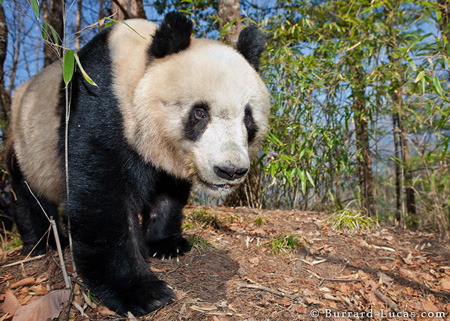Several basic techniques are used to obtain images of wildlife from a relatively small distance, but there are many factors that may determine not only which one should be used but also the details of how a photographer should proceed.
The first and most obvious approach is to make oneself relatively inconspicuous and settle down quietly in the appropriate habitat. It is also important to choose the optimum time of day, so having some knowledge of the habits of the species is certainly advantageous. If this approach is appropriate to the particular circumstances, and details such as location, time of day and personal clothing and behaviour are carefully considered, we may be rewarded when wildlife gets accustomed to our presence and gradually moves closer and closer to our position. Then, with suitable care and stealth, it may be possible to capture good close-up images.
 |
| Giant Panda - by kind permission of Burrard-Lucas.com |
A second basic approach is to create some sort of hide within which a human being can be concealed with at least a tolerable degree of comfort. Clearly the nature of such a hide depends to a large extent upon the particular location and circumstances. The most obvious way to conceal oneself is to sit in a car. Most animals and birds are far less concerned by the presence of a vehicle than by an unshielded human being. If a car can be positioned in a suitable location, it may therefore prove to be the most comfortable and convenient form of hide. However, where a vehicle cannot be used, a custom-made hide can be created relatively simply by any handyman. A simple metal-framed or wooden-framed box of suitable size, covered in canvas or some form of hessian in a suitable camouflage colour, makes a practical and transportable hide. In open countryside it may be necessary to support such a structure with guy ropes so it is not blown over in high winds. Curiously, some birds and animals seem to be happier in the presence of a hide under which clear space is visible - so it may be worth fitting legs and a wooden floor about a couple of feet above the ground.
There are a number of important considerations when planning to use a hide to photograph wildlife. Find out whether the species to be photographer is protected under local conservation laws and hence whether some sort of permit may be necessary. Protection of this nature exists for good reasons. The presence of a hide may draw attention to a bird's nest or an animal's location, and hence attract unwanted attention.The result could be cold eggs in a deserted nest, or young animals disturbed or injured. In some cases, observation of photography from such a hide may not be legal. Even if a hide is permitted, it must be introduced in to the area with sensitivity and moved closer to the desired location in small increments over a number of days or weeks. Once established, an human observer or photographer should be escorted to the hide by a second person who then departs from the location on their own. Animals and birds typically see little difference between one human being and two, and therefore seem to accept that the human disturbance has ended when a second person leaves. The reverse process should be adopted to retrieve the observer from a hide. Another consideration is whether permission is required to access private land. In many ways, locations on private land are the most practical provided no legal restrictions exist for the target species and the landowner's permission has been obtained. Hides erected on public land are likely to be seen and perhaps investigated by many more people.
When using a hide, it is essential to minimize any disturbance. The photographer must not only remain silent but also take care when moving equipment, changing lenses or even firing the camera's shutter. Do not suddenly thrust a large and shiny lens out of the front of the hide as this is likely to frighten the subjects. Watching a wildlife location can involve many hours during which little activity is witnessed. A reasonably comfortable sitting position is therefore worth a bit of additional preparation. Take drinks and perhaps a couple of sandwiches - but don't drop the vacuum flask or rustle food wrappers. Finally, when leaving the hide, make sure that it is properly secured so that it will not be blown over or cause disturbance when loose fabric flaps in the wind. In summary, put the interests of the wildlife ahead of your own!
Other methods for obtaining images from a reasonably close viewpoint incorporate the use of various types of remotely cameras. A camera can be set up on a tripod and triggered from some distance by a wired, infrared or radio link Another more flexible system is based upon small roving vehicles that can be positioned via radio control and camouflaged to merge in with the local environment. A final technique is to set up an automated "trap", perhaps using an infrared beam, which triggers a static camera when an animal or bird breaks the beam.






